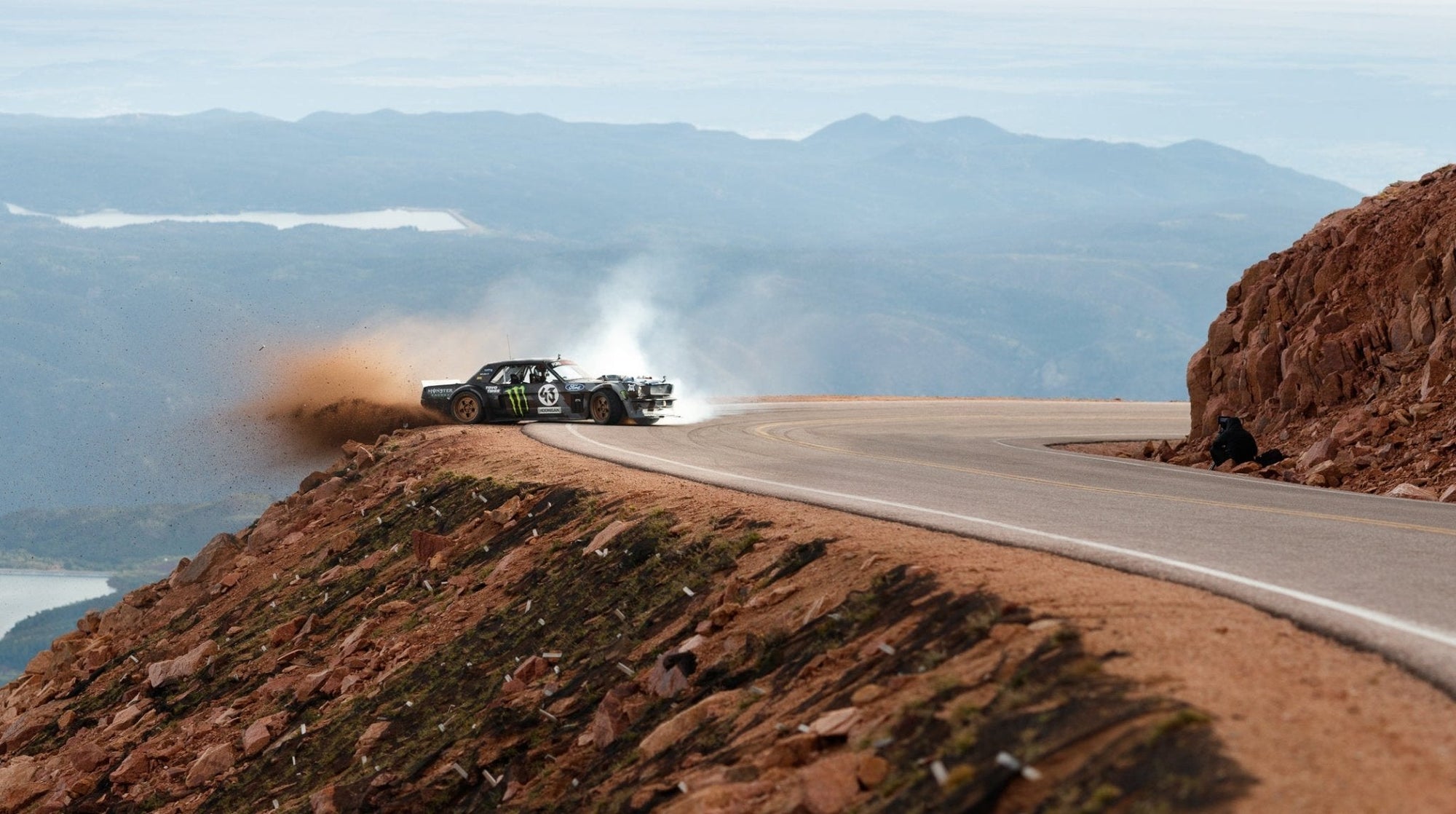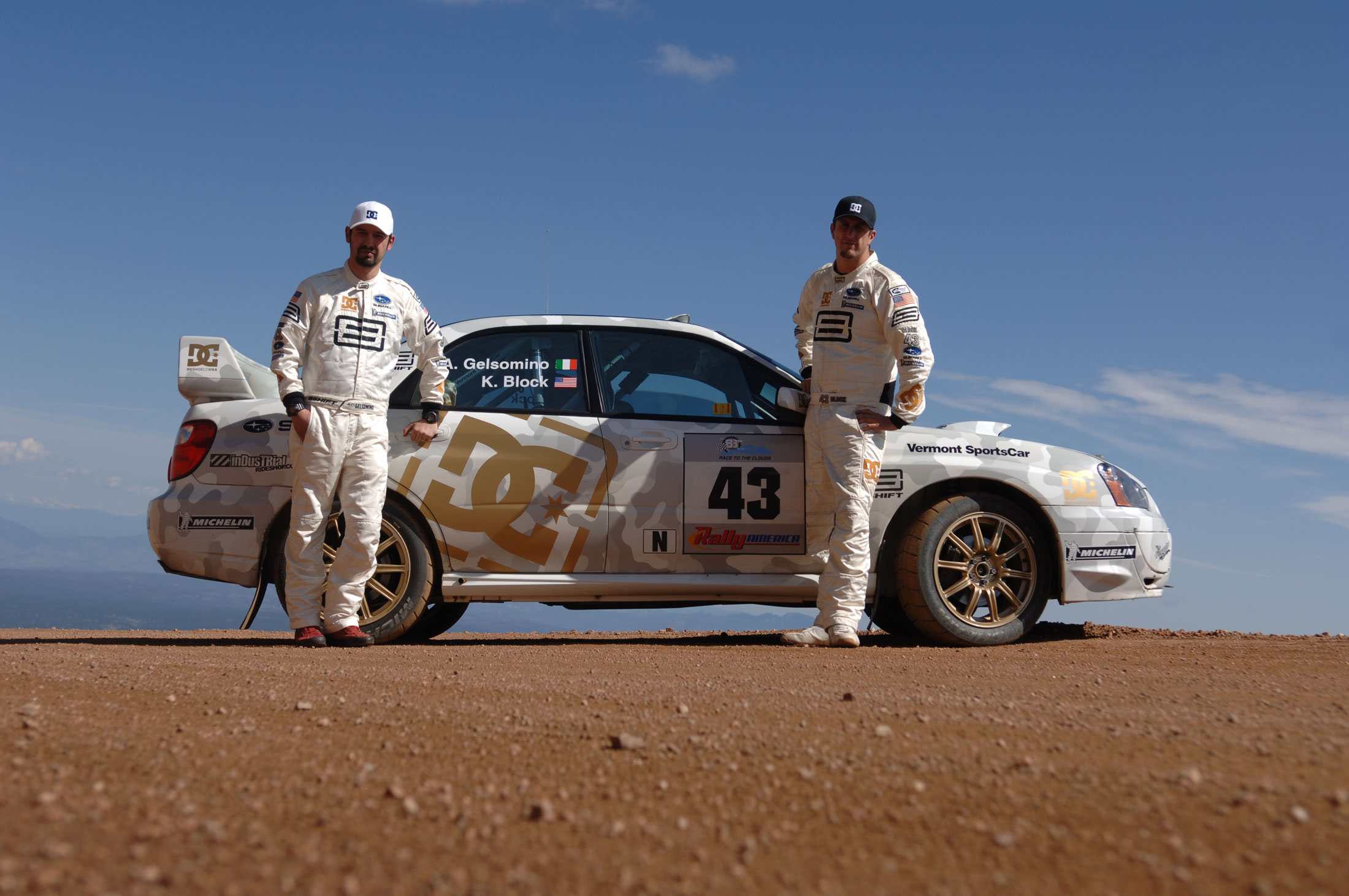The Crux Series - Pikes Peak with Ken Block

THE CRUX SERIES
HOONING ON PIKES PEAK
WITH
KEN BLOCK
The Crux Series is a collection of interviews with mountain experts that have a wealth of knowledge about each of the peaks in our glasses. In celebration of the launch of our Pikes Peak Collection in Colorado, we connect with Ken Block, a world renowned professional rally driver with the Hoonigan Racing Division, one of the co-founders of DC Shoes and all around insane man behind the wheel.
We were fortunate enough to talk with Ken in October of 2022 before his tragic passing in the winter of 2023. Our hearts are truly broken as we all lost an icon and a source of inspiration for many generations. Our love goes out to his family as they move forward through these unbelievably hard times.
Ken's rally career began in 2005 but his passion for racing started much younger. He has packed up numerous overall wins as well as plenty of podium appearances, most recently finishing 2nd in the 2022 ARA National Rally Championship. He’s also accumulated five X Games medals since the start of his career, including most recently taking silver at Global X Games Barcelona RallyCross in 2013.
In addition to his performance in the car, Block has been a driving force in shedding light on the sport of rally within the United States. His keen branding and marketing acumen, combined with his talents and skills behind the wheel, has also allowed Block to achieve global fame as a rally driver through his wildly successful viral Gymkhana series of videos. With all 10+ of his Gymkhana videos (plus all associated edits) clocking in at over 500 million views on the franchise in total, they have helped put Block in front of eyeballs around the world. Stay tuned in for his newest film Electrikhana featuring the Hoonitron inspired by the Audi S1 Pikes peak.
Ken's experience getting loose on Pikes Peak is what prompted us reaching out and connecting with this icon of action and motor sports. Dig in to learn more about Ken's connection to this iconic mountain and race.
WHAT IS YOUR CONNECTION TO PIKES PEAK?
Growing up as a kid in Southern California I was never interested in conventional motor sports like NASCAR or drag racing. I grew up skateboarding, riding dirt bikes, that sort of thing. In the mid '80s I saw some TV coverage of rally racing from Europe and some coverage of Pikes Peak. I saw that and was instantly drawn to it. The way the cars slid around the gravel and tarmac corners, the jumps, going sideways over crests in the snow. That was more interesting to me than cars going around in circles. I have no issues with conventional racing but it isn't what inspired me to be a race car driver.
When I saw cars racing up gravel roads like Pikes Peak, that's what got me interested in racing. Specifically Pikes Peak because cars like the Audi Quattro were being brought over from Europe to try to conquer and set records on Pikes Peak. Which they did. Watching Audi not only race in the World Rally Championship, but then bring the amazing all wheel drive cars over to set records and win Pikes Peak. I was a teenager at the time and I was really influenced by that. It made me want to be a rally driver and to eventually race up Pikes Peak. That's why I was always interested in Pikes Peak. It was always a dream of mine to be able to race there.

1987 Audi S1 Pikes Peak on course. The inspiration that started it all.
WHAT WAS YOUR FIRST EXPERIENCE ON PIKES PEAK?
Pikes Peak was part of the national championship during my first year of racing rally in 2005. It was done as a rally where the final stage of the rally was the actual hill climb. Previously, the racing and hill climb were done in various parts of the mountain as stages during the week. Shorter distance point A to point B stages with the final stage of the hill climb. I was in a lower horsepower car which is not what you want to run up Pikes Peak to set a good time. The elevation makes the cars run quite slow because of the lack of oxygen, so you need a real specifically built car to attack that mountain and put in a good time. I dreamt about this my whole life and I get to make this run up the hill, but I'm in a slow car for that mountain. It was a dream come true but then a major disappointment all at the same time. That's why I really wanted to someday go back and do the actual real hill climb race, as a hill climb, but in a properly prepared and proper horsepower car. To attack the mountain like I saw my heroes do back in the '80s.


It was a great way to experience it but that set me up for that desire to go back. That's what we did this year. We went with a proper car and a proper set up to go race the mountain. Unfortunately we had an engine failure in the Porsche 911, what we call the Hoonipigasus. The Engine failed right before the race and we didn't have time to replace or repair the engine to really put in a good run. Looks like I'll be back next year in 2023 to try and do it right.

THOUGHTS ON THE ROAD BEING PAVED VERSUS THE ORIGINAL DIRT ROAD?
It's a very dangerous road, so I can't imagine putting normal people in normal cars on the dirt road and being like, "Here, go for it." As a race car driver and growing up watching it all gravel it had a very distinct look of the cars sliding around. We made a film to pay homage to that version of Pikes Peak racing and the way that it used to be driven, called Climbkhana back in 2017. A lot of that film was done to celebrate how the cars used to slide around those gravel corners. There are big differences between gravel and tarmac. With the road all tarmac now you have to drive it much more like a circuit race road, which evens out the playing field. Whereas the gravel back in the day, every time the teams would show up the gravel would be in different conditions. Sometimes it would be very loose, sometimes more grippy. Everybody thinks it's a black and white issue, gravel versus tarmac, but it really isn't. Every time you show up to the mountain, even today, the asphalt will change because of how the winter was. If it was a really heavy winter it can make the tarmac at the top much bumpier and rougher. It can determine how the cars are set up and the overall time.
WHAT IS THE CRUX OF RACING PIKES?
The thing about racing a car at any time or any place is there's always going to be variables. Pikes Peak is like that but times ten. It can be hot and dry one day and hailing the next. You always have to be ready for a variable of conditions. The race is always run at the end of June, early July, which you would think the weather would be very consistent, but I've been there many times where conditions have changed by the hour. This year it was perfectly sunny the entire week leading up to it during everyone's practice and then it rained. On race day there was snow on top of the mountain and weather all the way up. The people who ran in the morning got an entirely wet, and sometimes icy, road. The weather there is so unique and that's one of the reasons why that race is so different from racing Formula 1 at Spa in Belgium, or racing rally in Kenya. You kind of know what the conditions are going to be and if it rains, it does make it a little different. With Pikes Peak it can be hot, there could be ice on the ground, it could hail, it could be sunny at the bottom and snowing at the top. It can be that wild of conditions that you have to prepare for. It really is one of the most unique races in the entire world.

WHAT IS YOUR TAKE ON EV'S AT PIKES?
I love my combustion engine cars but I also love technology and embracing the future as we’re trying to progress humanity and what we're doing on this earth. I love the idea of electric cars, I love being a part of the process and helping Audi develop their technology and marketing around electric cars. Whether you think it's the perfect future or not. I think any time we can take something like transportation and progress it into something potentially better, cleaner and better for the environment. I think it's very cool. As a race car driver at the end of the day, I just want something that will get me around the track faster. Electric motors are not affected in any way, shape, or form by altitude or air thickness. I've been working with the team at Audi to develop something really special, the Audi S1 Hoonitron. To be a part of developing that for me is just something very exciting. I think what Volkswagen did to create a car and go after that record was an incredible effort. The record before that was set by Sebastien Loeb in an incredible six cylinder engine car but Volkswagen with an electric car and another very good driver, Romain Dumas, have showed us what's possible.
Dig into the Hoonitron design story and full walk through below, well worth the complete watch!
IS THERE A MOST CHALLENGING SECTION OF THE COURSE?
The race course starts a bit slower and safer on the lower part and then goes up into certain sections where it's very fast. And when it climbs to the upper parts of the mountain there’s certain corners with 1,000 foot drops on the outside of corners! The engineers that put in the tarmac decided to put in some guard rails – but they're only in certain corners where the drops are the biggest. It doesn't mean that the guard rails are everywhere or around every dangerous corner so there's definitely plenty of places where you can go off and it's going to be very bad!
For me it's the middle section called the W’s. It's a bunch of hairpin turns and a corner called Evo corner that I slid the Hoonicorn on. To me those are some of the most challenging corners and where your memory needs to be the best if you're driving it as a race course. The corner named Evo corner is because a Mitsubishi Evo went off that particular corner. The driver thought he was in a different corner where you can basically go flat out on. He realized too late that the corner was tightening. He had too much speed and he went off the road, and tumbled 10 times down a 45 degree slope. The course is not only a big challenge for the car builders and car set up but the driver has to be able to memorize and drive the car quickly knowing how dangerous the course is. For me, that's one of the biggest challenges. Luckily, I grew up riding dirt bikes and had to memorize all the race courses that I was on. If you went too fast or too slow off of a jump, you could get hurt bad. That memorization of race courses has been with me since I was a young teenager. I’ve been able to memorize these things fairly quickly, but it really is a big challenge.
WHAT MAKES PIKES SUCH AN ICON FOR THE RACE COMMUNITY?
I think it's the challenge of the race. There isn't another road in the world where you climb from 9,000 to 14,000 feet and it's a race course. It just doesn't exist. There are other hill climbs around Colorado, America, and in Europe but there's just nothing like this road. Nothing with this history, this sort of height and challenge.

Bill Paine climbs through 16 Mile Corner in his 356A Speedster, the first Porsche ever to compete at Pikes Peak, in 1958
WHAT DOES PIKES PEAK MEAN TO YOU?
For me, it's one of the main reasons as to why I'm a rally driver. Rally enamored me when I was a teenager in the '80s. Audi went to Pikes and raced it in a car called the Audi Quattro S1E2 Pikes Peak. That car is one of the coolest race cars in history to me. That's the inspiration of the new Gymkhana car that Audi built me, that's how much we all adore that race car. For me, it really just has an amazing history, it's a really unique race, and all that combined just makes it one of the most iconic mountains and race courses in the entire world.

Audi Sport quattro S1. Credit: Audi Communications Motorsport
THANKS FOR THE ENDLESS INSPIRATION KEN!


